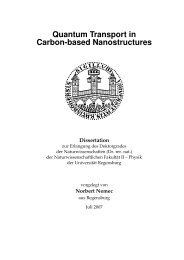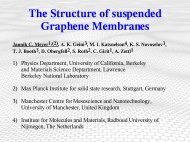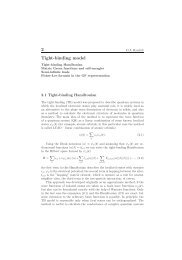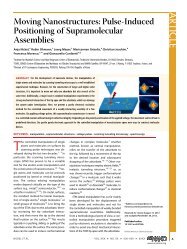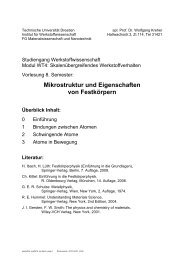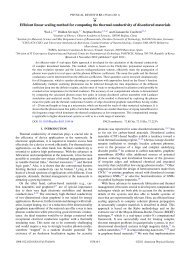4 Coulomb blockade
4 Coulomb blockade
4 Coulomb blockade
Create successful ePaper yourself
Turn your PDF publications into a flip-book with our unique Google optimized e-Paper software.
J [arb. u.]<br />
4.3 Single-electron transistor 79<br />
0 1 2 3 4<br />
V<br />
Fig. 4.6. <strong>Coulomb</strong> <strong>blockade</strong>: voltage-current curves of a symmetric junction at low<br />
temperature (T =0.01EC) and different gate voltages VG =0,VG =0.25EC, and<br />
VG = 0.5EC. Dashed line shows the change at higher temperature T = 0.1EC.<br />
Voltage is in units of EC/|e|.<br />
4.3.4 Current-voltage curve: <strong>Coulomb</strong> staircase<br />
Now let us discuss the signatures of <strong>Coulomb</strong> <strong>blockade</strong> at finite voltage. The<br />
results of calculations are presented in Fig. 4.6 for symmetric (νL = νR) system,<br />
and in Fig. 4.7 for asymmetric one. First of all, the gap (called <strong>Coulomb</strong><br />
gap) is seen clear at low temperatures and low voltages, that is the other one<br />
manifestation of <strong>Coulomb</strong> <strong>blockade</strong>. In agreement with conductance calculation,<br />
this gap is closed in the degeneracy points, where the linear currentvoltage<br />
relation is reproduced at low voltages. At higher temperatures the<br />
gap is smeared and linear behaviour is restored.<br />
The other characteristic feature, seen at higher voltages and more pronounced<br />
in the asymmetric case, is called <strong>Coulomb</strong> staircase (Fig. 4.7) and<br />
is observed due to the participation of higher charge states in transport at<br />
higher voltage. For example, if VG = 0 the transport is blocked at low voltage<br />
and the current appears only at |e|V/2 >EC (V/2 because the bias voltage is<br />
divided between the left and right contacts) when the <strong>Coulomb</strong> gap is overcome<br />
and the electron can go through the state |n =1〉. At higher voltage<br />
|e|V/2 > 3EC the state |n =2〉 become available, and so on.<br />
The general formula for the threshold voltages of the n-th step is<br />
Vn = ±<br />
2(2n − 1)EC<br />
. (4.43)<br />
|e|<br />
The amplitude of the steps is decaying with n and at large voltage the Ohmic<br />
behaviour is reproduced.





